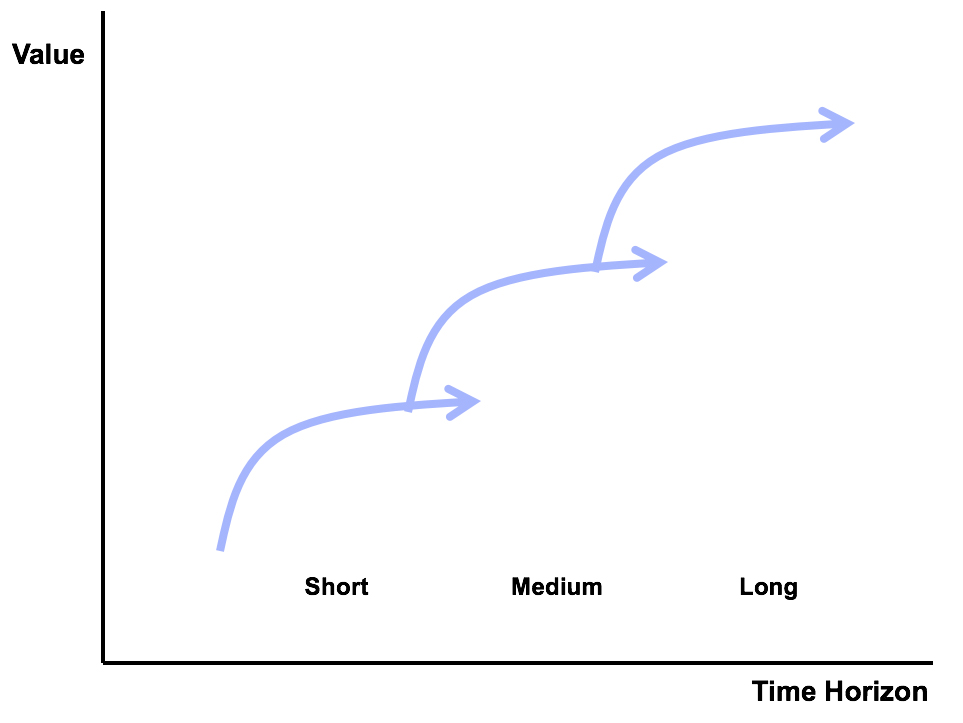A small fraction of companies manages to sustain profitable growth over time. Many achieve temporary growth, eventually eroded by competitors, while others maintain revenue growth without seeing a corresponding increase in value. Few succeed in growing value created over an extended period. This article sets out to shed some perspective.
A company’s opportunity to grow value creation successfully rests more on the duration and the type of growth than its magnitude. For instance, companies that grow value-added at 10% for ten years are worth more than those that grow a similar value-added at 15% for five years. This viewpoint leads to three fundamental principles for building a growth strategy.
TIME HORIZON
What time horizon is the company targeting? Corporations are usually exposed to three growth horizons: short, medium, and long-term. The reason is that as companies mature, they need to maintain a viable core business while capturing new sources of growth and avoiding decline.
Each horizon addresses different needs. In the short-term horizon, the objective is to maintain the core business viable and maximize its performance. In the medium term, the focus is on capturing opportunities for growth in the next 3 to 5 years, while in the long term, the aim is to identify opportunities for growth in the next 5 to 10 years. Exhibit 1 illustrates a conceptual framework.
Exhibit 1. Three Growth Horizons

As a result, and in practice, most companies need to manage growth along all three horizons simultaneously – an essential foundation of the growth strategy.
VALUE OF GROWTH
What is the value of growth for the company? It depends on the business. Businesses with high ROIC will value growth more than those with low ROIC. For a detailed view, see the side insert (Exhibit 2).
The Value of Growth
Exhibit 2. THE VALUE OF GROWTH
The Value of Growth for High ROIC Businesses
Businesses with a high ROIC-to-cost-of-capital spread benefit more from increased growth than productivity. We use a simple value driver model to value a company and illustrate the concept.
For a business with invested capital of $200 million and ROIC, WACC, and growth as reported in Exhibit 1, a 1% increase in growth yields a gain of $80 million, a 15% increase. By contrast, a 1% change in productivity produces $40 million, an 8% increase.

Therefore, this business will value growth more than productivity.
The Value of Growth for Low ROIC Businesses
Businesses with a low ROIC-to-cost-of-capital spread gain more value by improving productivity than growing. The reason is that growth doesn’t achieve a high multiplier effect.
For example, for a business with invested capital of $200 million and ROIC, WACC, and growth as presented in Exhibit 2, a 1% increase in growth yields a gain of $20 million, a 7% increase. On the other hand, a 1% increase in productivity delivers $40 million, a 14% increase.

Therefore, this company will value productivity improvement more than growth.
The key takeaway is that the value of growth for a mature core business is much less than that of a growing business with a high ROIC.
As a result, the concern for decision-makers is setting the right growth expectations and investments across businesses with varying ROICs and time horizons – an essential foundation of the growth strategy.
TYPE OF GROWTH
Not all growth is created equal: is the company aiming to gain market share or expand? Each objective is suited to a particular situation and raises specific concerns.
Gaining market share requires organic growth. The primary concerns are market potential and the company’s ability to gain achievable market share. Management needs to answer critical questions to determine the feasibility of organic growth:
- What is the size of the addressable market?
- What is the company’s achievable market share?
- How much does it need to invest?
- Is the resulting market share sufficient to satisfy the growth objectives profitably?
By contrast, expansion requires external growth to increase the company’s size and extract synergies. The main concern is the strength of the company’s business as a platform for acquisitions or strategic alliances. Management needs to answer fundamental questions:
- What are our company’s core strengths and competitive advantage(s)?
- Will an acquisition or a strategic alliance reinforce the company’s core strengths and competitive advantage(s)?
- By how much?
- Will the expected synergies be attractive enough to justify a deal?
A sound growth strategy strikes the proper balance between organic and external growth that fits the company’s context.
CONCLUSIONS
A comprehensive growth strategy requires trade-offs where a company invests today for higher sustainable returns in the future. Three principles help to work through these trade-offs and set the foundations for an effective growth strategy, including:
- addressing the right time horizon, often involving several
- quantifying the value of growth based on each business’ ROIC, and
- making a clear choice between gaining market share versus expansion.
Setting these foundations in place will put the company on a solid platform and growth trajectory and in a position to deliver sustainable growth beyond near-term incremental gains in the current market arena.

